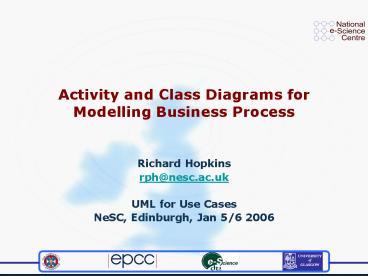Activity and Class Diagrams for Modelling Business Process - PowerPoint PPT Presentation
1 / 9
Title:
Activity and Class Diagrams for Modelling Business Process
Description:
Activity and Class Diagrams for. Modelling Business Process. Richard Hopkins. rph_at_nesc.ac.uk ... Construct a Class diagram of the entities involved ... – PowerPoint PPT presentation
Number of Views:81
Avg rating:3.0/5.0
Title: Activity and Class Diagrams for Modelling Business Process
1
Activity and Class Diagrams for Modelling
Business Process
- Richard Hopkins
- rph_at_nesc.ac.uk
- UML for Use Cases
- NeSC, Edinburgh, Jan 5/6 2006
2
Development Process
Partially articulated requirements
to elucidate requirements what entities exist
and how each behaves
Capture Requirements
Use Case Diag.
Requirements
Construct Model of Overall system
Class Diag.
Structure
Behaviour
3
More Technical Diagrams
- Activity Diagram
- Flowchart
- Deals with the whole behaviour of one actor
- Class Diagram
- shows the structure of the types of entities
involved in the system - These are more complex diagrams
- Usually used for the Software design internal
operation - Can be used to describe external operation
- Might be useful in clarifing requirements
4
Activity Diagram (flowchart)
Swimlanes separate Actors persons or systems
user
librarian
Find Book on shelf
borrower
returner
returning
borrowing
Synchronisation bar Start/Collect concurrent
activities concurrent non-sequenced Any order
or parallel
decision
activity
guard
transition
Start / stop
5
Class Diagram
User
Item
Student
Staff Member
Journal
Copy
Article
Book
- each box represents a class of entities
- here real world entities
- Generalisation ( Inheritance)
- Every StaffMember is a User
- Every Student is a User
- If User can do it, so can Student and StaffMember
- Every Book is an item Every Journal is an item
- Doing something to an item means doing that to a
book or to a Journal - To facilitate understanding of / communicate
about - The application domain
- NOT the structure of system implementing it
6
Class Associations
User
Item
Is part of
contains
has out
Is copy of
Student
Staff Member
Journal
Copy
Article
Book
has out
Ordered print-off
- Associations knows about
- there is an association line if there is a
relevant real-world association - any user can have out a copy (of a book)
- a Staff Member can have out a Journal
- an article can be part of a Journal
- .
- only label one end
7
Multiplicities
Number of Copy objects that can be associated
with one student object At least 0 At most 6
0..1
Student
0..6
1
1..
Exactly 1
Copy
Book
has out
Is copy of
0..12
Staff
0..1
0 or 1
At least 1,no upper limit
- Constrains the number of entities at one end that
can be associated with one entity of the other
end (in this association type, at any one time) - Either single number (usually 0 or 1)
- Or range X .. Y.
- for Y means no upper limit
8
Questions?
9
Practical Business Process Model
- Working in groups
- For the system of your Use Cases
- or some other groups
- E F seem to me to show relatively little
potential for entity structuring - Construct a Class diagram of the entities
involved - Construct an activity diagram for (part of) the
behaviour of one entity class - How easy? How useful
- Use pencil paper or VP-UML
- 2 hours (ish)































